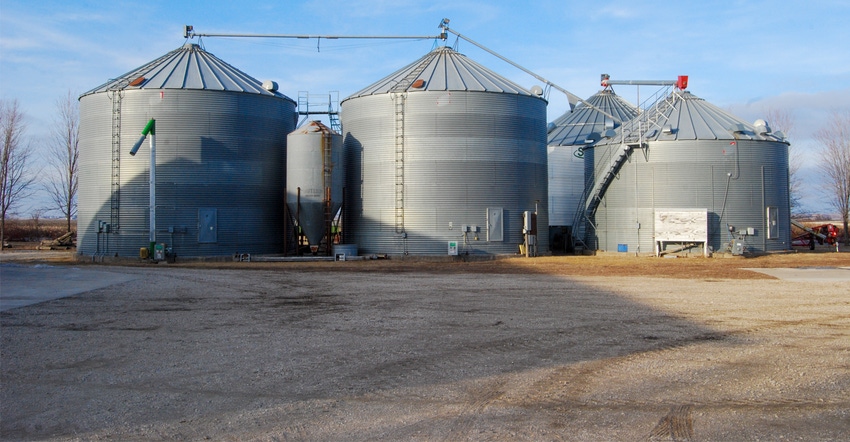February 1, 2018

By Steve Johnson
The latest USDA estimates show U.S. corn stocks forecast for the end of the current marketing year at levels not seen in 30 years. And soybean ending stocks forecast for Aug. 31 are greater than seen in a decade.
Not all of this huge supply of corn and soybeans is stored in on-farm bins and in elevators. There is a lot of corn in temporary storage this winter — big plastic bags on farms dot the countryside. And outdoor temporary piles are sitting covered, on concrete pads next to grain elevators. As weather warms in late winter and into spring, much of that grain will need to be picked up and moved to market.
Trying to merchandise unpriced corn and soybean bushels this winter above the cost of ownership will continue to prove challenging. Nearby March futures contract prices for corn and soybeans hover around the same levels they were during harvest. While basis might have improved slightly, the cost of grain ownership, which includes storage and accrued interest, may still exceed any improvement in cash prices being offered today.
Futures seasonal price trends
In developing a marketing plan for your old-crop bushels, move beyond outlook and consider the basics: futures seasonal price trends, futures price carry, local basis and your own cost of grain ownership.
Since the 2014 U.S. growing season, corn and soybean futures prices have peaked in a time frame from early April to mid-July. That’s about when 85% of the world’s feed grains and nearly 50% of the oilseed crops are typically produced. The uncertainty of South American production can also provide higher futures prices in mid-November to January. These are referred to as the seasonal futures price trends.
With large U.S. and global ending stocks of corn and soybeans, weather rallies should be rewarded as they tend to be short-lived. Have a marketing plan with a price and time objective, stay tuned and be ready to finish old-crop and make adequate new-crop sales.
Capturing futures price carry
Futures carry is defined as the difference between the nearby corn or soybean futures contract prices and those for the more distant or deferred months of May and July. By late fall, futures carry was 30 cents from December to July for corn and nearly 40 cents from November to July for soybeans. This amount was nearly full carry and would likely have covered the cost of on-farm stored bushels but not those bushels stored commercially.
However, to capture this carry a farmer would have to sell futures in the deferred months (May or July) via a hedge, or initiate a hedge-to-arrive (HTA) contract using those same months and make a spring delivery of bushels. That basis could then be set in the spring when basis tends to narrow as compared to the winter months.
Pay attention to your local basis
Basis is simply the local cash price minus the nearby futures contract. It reflects the local supply and demand for corn and soybeans, while varying by processor, elevator or co-op facility. Basis patterns tend to improve (become less negative) by mid-November when harvest wraps up and bushels are stored away. Most of that basis improvement is realized by early January.
It’s this January and February time frame that an excessive number of bushels are delivered primarily for cash flow purposes, and basis tends to stagnate. Expect that to occur in 2018 as a smaller number of corn bushels were preharvest-marketed, yields were larger than expected, and cash flow needs could be larger come the late-winter months.
Your cost of grain ownership
Knowing your cost of grain ownership for stored bushels is critical. Storing bushels on-farm where grain bins are paid for could be as little as 1 cent per bushel per month. However, bushels stored commercially will likely be closer to 5 cents per bushel per month. When you add in accrued interest at 5%, the cost of corn ownership could range from 2 cents to 6 cents per bushel per month. The cost of ownership for soybeans could range from 4 cents to 8 cents per bushel per month, as the value of soybeans is roughly three times that of corn and leads to larger accrued interest charges.
Don’t be surprised that cash price improvement by spring doesn’t exceed the higher costs of commercial drying and shrink in addition to storage costs. In addition, the wider basis at a commercial storage facility will be difficult to overcome. Perhaps the greatest benefit of storing bushels on-farm besides harvest efficiency is that it allows the farmer more time and improved chances to shop around for better cash prices reflected in basis. This will likely be true of processor bids, but not necessarily local elevators and co-op cash bids.
New tool compares cash grain bids
ISU Extension has developed an easy way to compare various cash grain bids while reflecting your transportation costs. The Grain Bid Comparison Tool, A3-41, can be found on the ISU Ag Decision Maker website; or, simply search the internet for “Grain Bid Comparison Tool.”
Collect up to five cash grain bids from various locations and input these cash prices into the Excel spreadsheet, along with your own estimates of operating costs and distance to haul the grain. For new-crop corn bushels, adjustments should be made for higher moisture content to adjust for drying and shrink discounts. This decision tool allows for comparing a variety of what-if scenarios for selling grain at various cash prices while considering your own transportation costs.
Johnson is an Iowa State University Extension farm management specialist. Contact him at [email protected].
You May Also Like




